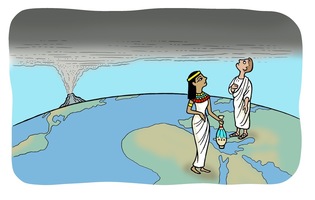 loading
loading
FindingsWhy the Roman Republic fellA volcano likely played a part.  Gregory NemecView full imageIt was early spring, 43 BCE, and Roman soldiers were eating roots and tree bark to stave off hunger. They were cooking animals “never tasted before by men,” according to Plutarch. Eighteen months later, food shortages persisted. Antony wrote to Cleopatra pleading for grain, but she could not help, she said. She had her own famine to manage. Supplies were no doubt suffering from the recent assassination of Julius Caesar and the violent unraveling of the Roman Republic. But a new paper in the Proceedings of the National Academy of Sciences suggests that the cataclysmic eruption of a volcano 6,000 miles away also may have been a factor. A group of researchers has linked the traces of volcanic ash in ice cores from Greenland and Russia to Mount Okmok, a volcano in the Aleutian Islands. With unprecedented precision, they dated the ash to two consecutive eruptions: a minor one in 45 BCE, and one in 43 BCE that is one of the largest in recorded history. The researchers used simulations to model the eruption’s potential effects in the Mediterranean. They found a drop in average seasonal temperatures of up to 13 degrees Fahrenheit, as well as disruptions in the East African monsoon—which produces Nile floodwaters essential to agriculture. “This is a time when the Mediterranean region was undergoing major transition,” says Joseph Manning, a professor of history at Yale and coauthor of the article. Roman generals were vying for power; Egypt’s longstanding Ptolemaic dynasty was embroiled in war and slipping from power. “And then there is this huge eruption that appears to have a decade-long impact on the climate—boom, now deal with that.” Manning aims to write a historical account that integrates all the factors. “Politics, economics, and military power matter, but nature has some say in this story, too.”
The comment period has expired.
|
|